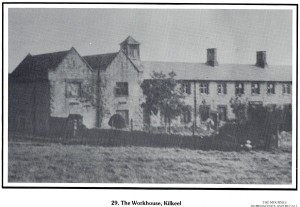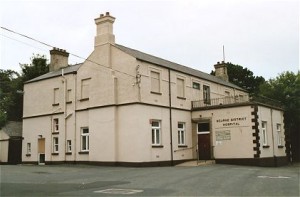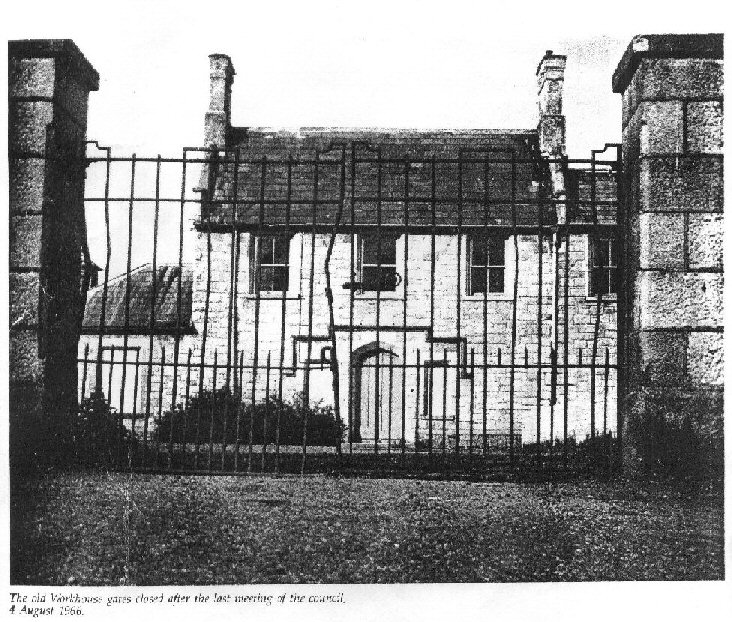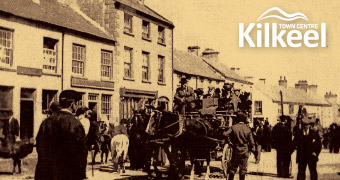The Irish Poor Law Act of 1838 divided the country into Unions and there was to be a workhouse for each Union. Many types of people could be found here, those too old or ill to support themselves along with those who could have lost their farms or employment and had no means of income. Women who had children outside of marriage were also sent to the workhouse, as unmarried mothers were shunned. People who were mentally ill or disabled were also housed here.[1]
Kilkeel Poor Law Union was declared on 29 July 1839 and covered an area of 127 square miles. The operation of this was overseen by a Board of Guardians.
The population within the chosen Union in the 1831 census was 26,833 altogether. It covered an area of 81,726 acres. The union included town lands of Kilkeel, Killowen, Ballykeel, Bryansford, Fofanny, Greencastle, Maghera, Mourne Park, Mullartown and Rostrevor.
The Kilkeel Workhouse was erected in 1840-1 on a 7.5 acre site on Newry Street, Kilkeel. The land was bought for £462.7.6, and £20 compensation was given to the occupying tenant. It was designed by George Wilkinson, a Poor Law Commissioner’s architect. His building was intended to house 300 inmates. The construction of the building cost £4050 plus £767 for fittings. The workhouse was approved on 16 August 1841 and admitted its first inmates on 1 September.[2]
Below is a map showing the location and layout of the Workhouse, dated 1930.
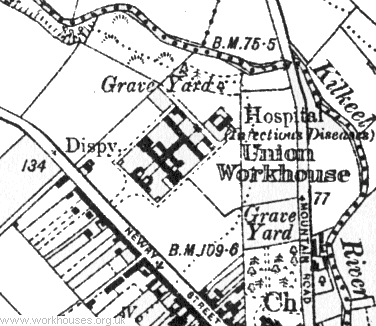
The building contained a waiting room and a board room for the Guardians on the first floor. The main block had male and female wings on either side of the masters quarters along with rooms at the rear such as a washhouse and bake house, an infirmary, an idiots ward and a chapel and dining room.[3]
During the famine which lasted from the mid 1840s-1851, a forty bed fever hospital was built on the site. This fever hospital survives today as Mourne District Hospital.
Evidence suggests the famine did not have as big an effect on Mourne as in the rest of Ireland. Looking at the minutes from the Board of Guardians meetings from the period demonstrates little sense of urgency or panic. A meeting in 1846 states that there are ‘no patients in the Fever Hospital’. On 15 July 1846 the Board discuss a letter from a Dr. Coole/Brooke. In this letter he claims it is necessary to provide ‘medicine and nutriment’ to the poor persons at their own homes, as they had a disinclination to enter the hospital. The Board responded by saying, ‘there are very few cases of fever in the District referred to and they are of opinion that there is no necessity of providing medicine and nutriment at present.’ This suggests that Mourne got off quite lightly. There is no doubt life would have been more difficult, but they did not seem to get hit hard like the rest of the country. However the Board does mention the workhouse’s supply of potatoes ‘running out’ in one instance but simply replaces their food with bread, soup and stirabout.[4]
By 1847 things were maybe worsening. In a meeting on 7 April the board employs an Alexander Robinson ‘to draw patients to Fever Hospital in fever cart as follows: from… Kilkeel, Mourne Park, Greencastle, Ballykeel, Mullartown and Killowen at 3/6 for each journey; from… Fofany, Bryansford, Maghera, and Rostrevor at 7/6 for each journey.’ [5]
Most people believe the reason Mourne survived the famine so well was due to the fact that they had an understanding Landlord. During the famine the Earl of Kilmorey began building what would become known as the ‘famine wall’, to give people employment during the rough times. This is just one example of how he tried to help the people living in his estate.
[1] http://www.youririshroots.com/irishhistory/workhouses.php
[2] Parliamentary Gazetteer of Ireland 1844-5.
[3] http://www.workhouses.org.uk/Kilkeel/#Records
[4] PRONI BG SVI/A/3 and Minute Book of Kilkeel Board of Guardians, January 1846, p.134.
[5] PRONI BG SVI/A/3 and Minute Book of Kilkeel Board of Guardians, January 1846, p.259.
